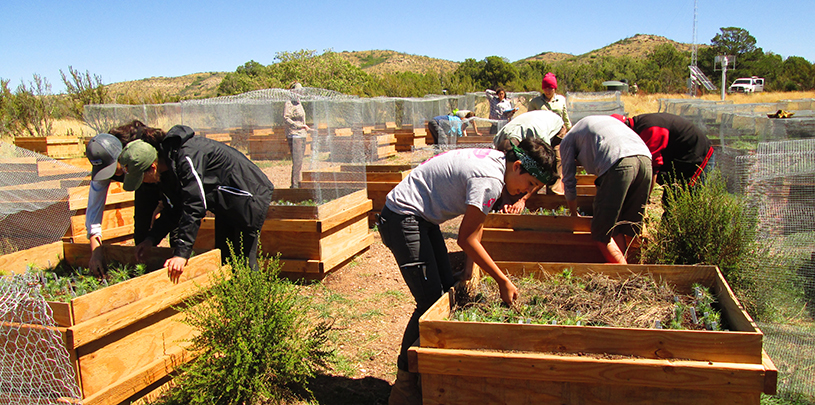
 Guest post by Maya Holliday, Flagstaff High School Student
Guest post by Maya Holliday, Flagstaff High School Student
As the wind whistles through the ponderosa forest on a September afternoon, I sit cross-legged beneath a weather station tower, laptop in hand, yelling numbers into the cloudless sky. Well, not just into the sky. I’m actually yelling numbers to Paul Heinrich, a researcher and all-around handyman, who has climbed to the top of the tower and is swiveling an antenna around in search of a stronger signal. Near us, people take measurements of hundreds of southwestern white pine seedlings. These seedlings, which Paul and his colleagues hope to soon remotely water, are the reason we are here.
I’m back on the North Rim with my Flagstaff High School classmates, the Grand Canyon Trust, and the Southwest Experimental Garden Array (SEGA), a multi-organization, multi-site research project studying the effects of climate change on the Colorado Plateau. Three of us students are returners, but the other eight are here for the first time. Some of our tasks are familiar to me, like collecting data on southwestern white pine seedlings. But some things, like pipe welding and mulching the white pine boxes, are entirely new.
We are tiny and crucial worker bees in the vast hive that is SEGA. If you zoom out even farther, you see SEGA building and maintaining garden sites across northern Arizona, using an altitude gradient to simulate the effect of climate change on temperature and precipitation.
But for now, zoom back in on this group, specifically on our AP Biology teacher, Linda Lenz. She has found a way to bring her students to SEGA, and SEGA back to her students.
Last April, when 11 of us came back from a SEGA trip, our school courtyard was wasted space, full of weeds and invasive plants. But since then, we’ve transformed it into a hub of environmental teaching and research.
For the past few weeks, Flagstaff High School senior Tayler Garcia has been creating miniature garden sites for the southwestern white pine research project, right here in our courtyard. Just like the larger sites we’ve worked on in the past, we’re planting seedlings in boxes, where we carefully monitor their growth to contribute to the larger body of research dealing with white pines and climate change.
Ms. Lenz presides over it all, bouncing from group to group, donning a pair of boots and climbing into the eyesore of a pond to cut holes in the plastic lining. TerraBIRDS (a local group that plants school gardens) carefully helped us plan the gardens for our courtyard last April, and now they are thriving. Everything is coming together in a wonderful melding of conservation and environmental learning. CEGA (the Courtyard Experimental Garden Array) is growing right before our eyes and getting more students out of the classroom and into their environment.

Flashback to the last day of the September trip: The 14 of us are sitting in the shade of Lower Cathedral Wash, still damp from a dip in the Colorado River. As we talk about the lessons learned from our experience, a condor flies into the perfect blue sky, framed by red cliffs. After we’ve all ooh-ed and ahh-ed, we fall quiet, our necks craned upward. Sitting in silence, I remember why we’re here. The Colorado Plateau is a magical place, full of surprises at every bend, and we are here to advocate for it.
As 2024 draws to a close, we look back at five maps we created this year that give us hope for 2025.
Read MoreA small victory in the legal case challenging Daneros uranium mine, near Bears Ears National Monument.
Read MoreMugs, handmade soaps, high fashion, jewelry and more. There's something for everyone on your holiday shopping list.
Read More